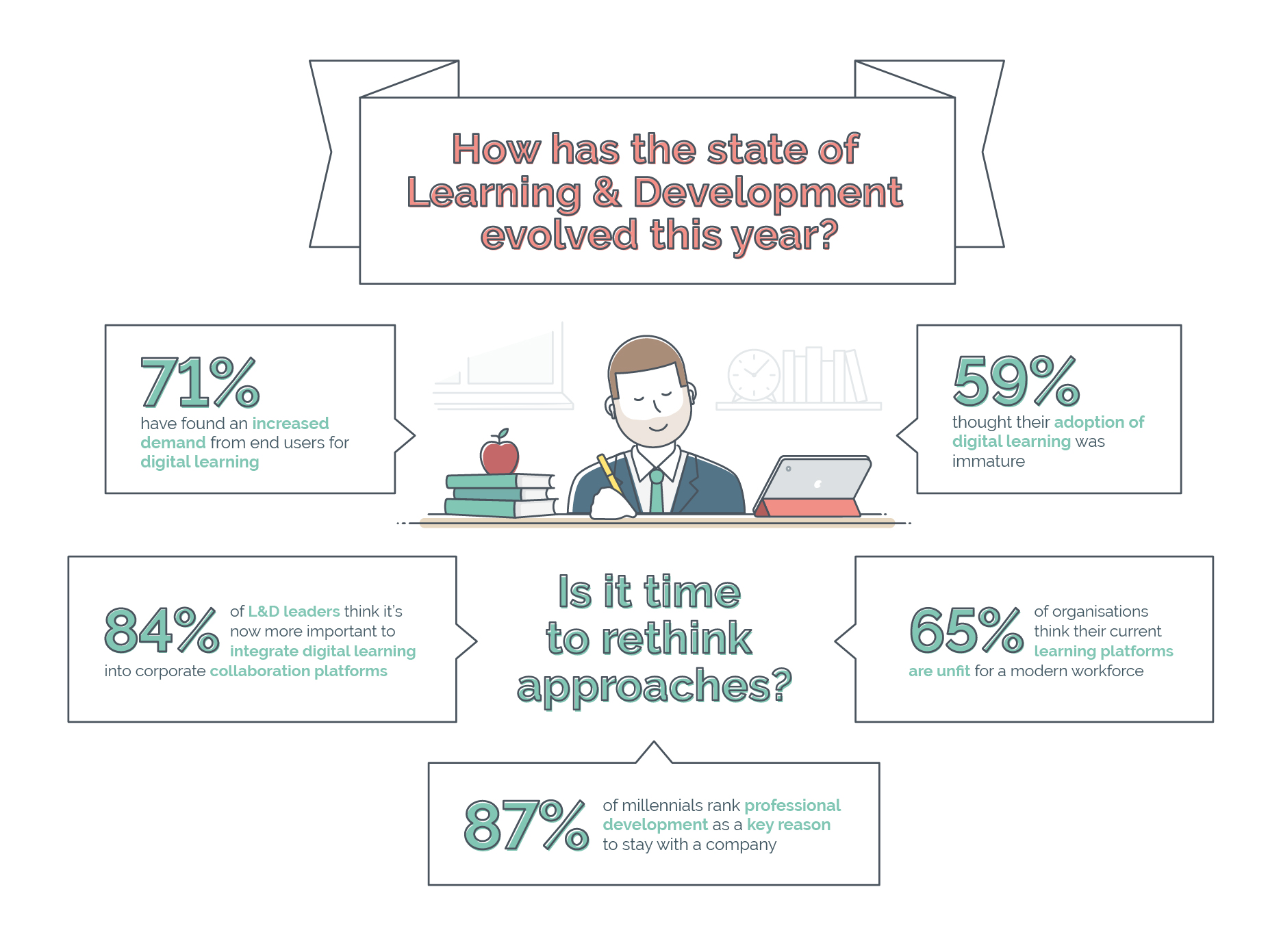No matter what the job is most workers and employees will need to go through training, learning and development in some form at some point. It will vary drastically between sectors amongst other factors but generally it can be split into three distinct categories: mandatory (for example, health and safety or IT security), career related (project management), and personal development (communication and presentation skills). In the corporate world learning has received more pronounced attention (and subsequently investment in many cases) from executive and people teams in recent years, especially as demand for learning opportunities builds with each new generation entering the workforce, and with more readily available opportunities to demonstrate upskilling across your career. Scan the careers section on LinkedIn and you will spot ‘learning’ playing an integral role in many organisations EVP, or just being an essential compliance piece for effective employees.
However along with demand, expectations are also growing. Organisations are eager to stay relevant and keep their employee experience offering innovative, but so often people keep circling back to LMS platforms with no personalisation or personality. You can only reinvent the same content or processes so many times, and L&D professionals today find themselves in a battle for people’s attention in a world that has had to move so many events and strategies entirely online. Equipped with all the benefits of technology, but perhaps still facing a delay until we can have face-to-face sessions again, how can we reinvigorate and enable L&D to ensure participation, commitment, and engagement?
Video is King?
Video has long been the first step for online learning settings, and it is particularly useful when virtually replicating what otherwise would be happening in a classroom based or face to face environment. Quick videos suit the attention span of today’s learner, and conferencing helps encourage connecting and collaborating across locations. There are plenty of advantages that video content can bring to the professional world. It has the potential to be delivered at any time often on any device, it can be made bite sized, it can be made collaborative, autonomous, virtual, the possibilities only grow with technological advancements. But in the same breath, so does video exhaustion. Zoom has seen a growth from 10 million meeting participants per day to over 300 million per day since the start of January 2020. It has been used for everything from virtual coffee mornings to delivering webinars. Whilst the online move was vital for the events space and has shown great lengths of creativity behind L&D, even by the second month of lockdown many were feeling saturated, facing webinar overload, and most concerningly worrying about the potential impact on career progression and stagnation over time.
Video undoubtedly does enable more dynamic content production, but it doesn’t always allow for inter-personal or spontaneous moments that develop naturally in person and this has been noticed profoundly since lockdown. Conferencing and video both have a tendency to fall flat when it comes to personal and professional development. Individuals are lacking the communication and collaboration required to thrive, develop, and pick up those soft skills from being immersed in a physical environment with others. It can feel hard for people to feel like they’re progressing, learning, or on track with their development when it’s just them and their screen all day every day, they’re having to prove their skills and aptitude purely online. This is where a balance between technology and human interaction becomes important. There are plenty of digital solutions to connect A to B or carry messaging. To support people’s innate drive for relatedness, autonomy, mastery and purpose any implemented technology needs to facilitate experiences that address and interpret the core needs of the people involved.
People need more of a hook with compelling content in order to build engagement and commitment to the learning path.

Not Just Playing Games
A 2019 survey found that 83% of the respondents receiving gamified training felt motivated, versus only 28% for those undertaking non-gamified training. When gamified elements were added to training, boredom dropped to 10%. And although integrating gamification into training or L&D isn’t new: right now, there is a great opportunity to delve further into its possibilities.
Think about traditionally content heavy training: we have all been faced with reading through pages upon pages of health and safety, corporate rules and regulation training that is often difficult to absorb. Translating this content into a virtual gamified experience has been show to be a particularly effective approach for helping to deliver consistent experiences in a way that employees can ‘digest’ easily, interpret
That said, hesitations around gamifying experiences is understandable, particularly when trying to deliver essential or meaningful training, such as how to improve communication or diversity awareness. But gamification doesn’t always just make something fun. It can be a stimulating element for ensuring learning transfer, through more meaningful recognition techniques, visualising progress, or simply by integrating levels or tutorials to help people find their feet on a new course. In the absence of face to face training, simulation and scenario-based training can be a great substitute, especially with the advent of more affordable technologies such as Virtual Reality. Applicable for more practical roles when you’re not yet able to put skills to the test in reality, like practising beauty treatments or developing trade related skills safely. This kind of immersive approach can be used for this by putting people in realistic, but safe situations – just like you would in a role play in face to face training, but without the nervous laughs and self-consciousness. When considering VR, research shows that the added movement associated with being able to move your head and even arms can increase a participant’s feeling of empathy during the experience, which can make a huge difference for people in customer facing positions. Or as part of recreating or simulating everyday experiences within a virtual environment, participants can create avatars to explore content, courses and locations, in a much more direct way.
Once you lift the experience from the classroom, the opportunities and approaches are endless. So whether it’s recreating a training event on a group video call, developing and providing a gamified experience or a virtual world: the common denominator in what will make each approach successful is the focus on making it an engaging experience, made accessible to potentially all employees irrespective of location. It might not be a full replacement for everyone being in a room together, but it’s certainly one step closer, and a way that training, L&D can be provided more naturally. Still providing something insightful, engaging and valuable yet is capable of evolving with changing circumstances and requirements. And not forgetting, providing an element of fun along the way!








